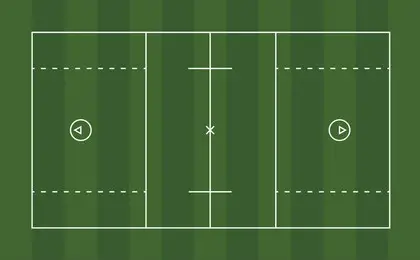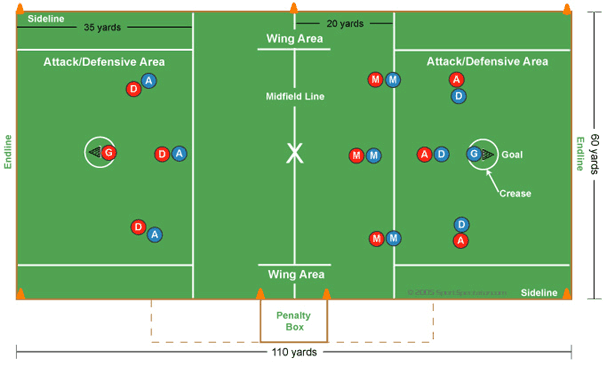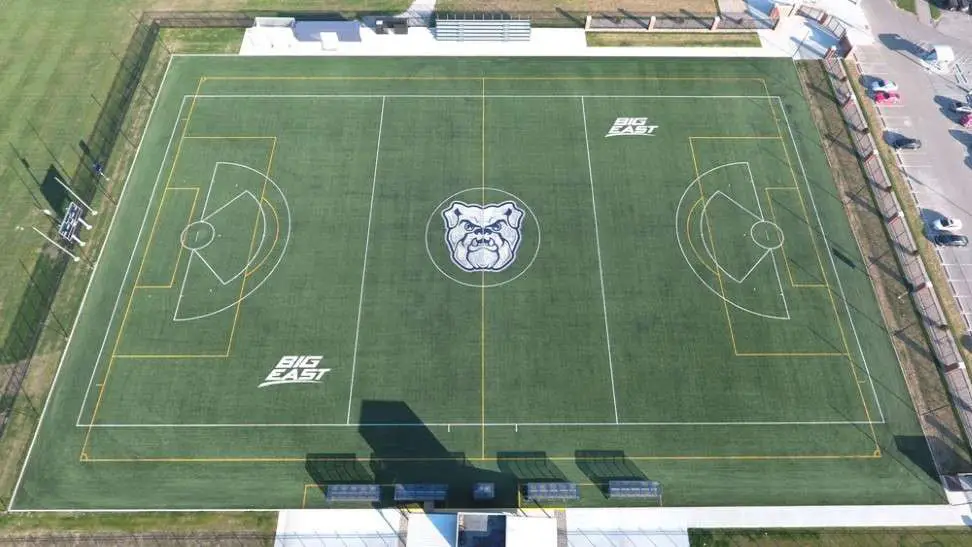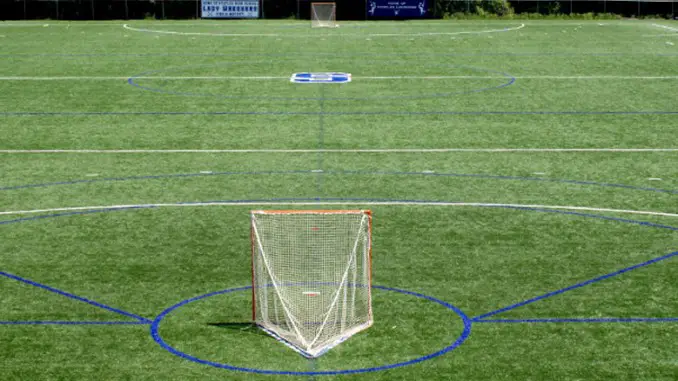Lacrosse is a sport that has tremendous cultural and historical significance in North America. At the very beginning, lacrosse games were played over many miles and lasted multiple days. There were no official lacrosse fields but a wide and big stretch of terrain or land. Today, lacrosse has become one of the most popular sports around the world, sharing the same regulation fields of grass.

To become a great lacrosse player, the first step is to get to know the lacrosse field and the rules. Currently, the legal lacrosse field is 110 yards (101 meters) long and 60 yards (55 meters) wide in between the sidelines. It’s slightly bigger than a football field which is 120 yards long x 53 ⅓ yards wide.
Regardless of your skill or age level, men’s and women’s lacrosse fields all share very similar sizes.
- NCAA Men’s lacrosse field: 110 yards x 60 yards
- NCAA Women’s lacrosse field: 110 – 120 yards x 60 – 70 yards
- Youth lacrosse field: 110 yards x 53 ⅓ – 60 yards
Now we have an overview of the field dimensions; it’s time to dive into the details and the specific parts of the lacrosse field.
The Standard Layout For A Lacrosse Field
No matter how you slice a lacrosse field, there are five major sections on a lacrosse field. In this section, we will break down every section in detail including their respective dimensions.
This diagram will serve as the tool to understand where each section is located and how exactly a lacrosse field is structured.

Offensive Area
In a glance, we see a pair of lines, 20 yards (18 meters) from both the midfield line and the goalie line dividing the entire field into three sections. Depending on your team’s point of view, the farthest section of the three is called the offensive area.
It’s 35 yards (32 meters) wide and 40 yards (36 meters) long. The area is enclosed by the restraining line, the end line and the sideline.
The restraining line is the trisecting line that extends all the way to the sideline and creates the restraining box. This box is 10 yards away from the sideline and reaches the end line.
The end line marks the end of how long the field is behind each team’s goal area.
The sideline marks the end zone of how wide the field goes beyond the wing line.
Defensive Area
The defensive area is identical to the offensive area in terms of dimensions, but it’s the nearest section of the three. Again, it’s 35 yards (32 meters) wide and 40 yards (36 meters) long.
Midfield Area
Midfield Area is 60 yards (55 meters) wide and 40 yards (36 meters) long. It’s enclosed by both restraining lines and the sidelines. It’s bisected by the middle line. Right in the center of this area, there’s a circle with an X in the middle, which is called Face-Off X.
Wing Area
The wing areas are a unique section to lacrosse. The wing areas are essentially a pair of alleys that are located ten yards in from the sideline and lie perpendicular to the middle line. In dimensions, they are 110 yards (100 meters) or however long the field is and 10 yards (9 meters) wide.
The field lines, a.k.a wing area lines, dictate where the two nonface-off middies from each team lineup prior to a face-off. The lines are 20 yards (18 meters) long and are 20 yards (18 meters) away from the Face-Off X.
Goal Area
The goal area is centered between each sideline. The goals are positioned 15 yards (14 meters) from the end line and 80 yards (73 meters) apart from each other. The circle that encloses the goal area is called the crease. It has a 9-foot radius.
The line that the goal rests on is referred to as GLE (Goal Line Extended). It serves as a boundary where if an offensive player breaks in, it’s a quality shooting opportunity.
Can Lacrosse Be Played On A Football Field?

Absolutely. In fact, lacrosse games and practices at high school and collegiate levels use the football field as the primary field. A couple of major benefits of using a football field are the following
- A football field is very common and convenient to find
- A football field is very similar in dimensions
- Lacrosse runs on the freedom to run and sprint across a wide space. A football field offers that
- Reduces vacancy and maximizes usage as lacrosse takes place in the spring whereas football kicks off in the fall
Although the markings of a football field don’s match exactly with the markings of lacrosse, game officials often use cones and spray paint to mark off additional lines for lacrosse games. Aside from that, a football field is a great and best value alternative to constructing an exclusive lacrosse field.
Lining Up on A Lacrosse Field
The markings on the field also play an important role in indicating to players where to position prior to a face-off. Each team starts with ten players who are segregated into three zones, offense, defense and midfield. So the defensive four including the goalie are in the defense zone; three players each are in the midfield and offense zones.
Players must stay inside their respective areas until the possession is made by either team or the ball crosses either restraining line. Each team can have four d-poles on the field, and typically three defensive players are three d-poles and then there is one d-pole middie, which is called LSM.
The arrangement changes depending on the strategy. For example, if one team wants to gain more advantage during face-off they would put two LSMs in the midfield.

Pro Tips For Beginners
To wrap up this explained post on everything you need to know about a lacrosse field, I want to include some beginner tips you can utilize to take advantage of the lacrosse field and the rules.
- When you are running by the sideline, keep your stick close to the sideline. It naturally creates a shield from opponents reaching over.
- There have to be 3 players inside the offense area and 4 players inside the defense area at all times. But players are free to move to any side after a faceoff.
- Always communicate with your teammates on the field, especially starting out.
- There are no rules against stepping out in the middle of a game. You can step off for a quick water break as long as the ball is on the other side.
- Pay attention to your coach’s instructions. It’s easy to get overwhelmed during a game, so listen to your coach for guidance and quickly adjust.
To take your game to the next level with the best practice and training, check out the training page to learn more.
To pair your game with the best equipment, check out the equipment page to find the best on the market today.





